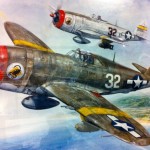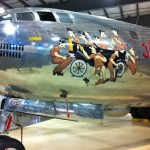 It was a beautiful machine now standing proudly basking under the fluorescent light of the immense hanger. Though not alone the B-25 Mitchell bomber stood out amongst the more modern jets, it’s guns protruding from the nose.
It was a beautiful machine now standing proudly basking under the fluorescent light of the immense hanger. Though not alone the B-25 Mitchell bomber stood out amongst the more modern jets, it’s guns protruding from the nose.
For a brief moment I felt alone imagining myself flying such a classic and historic aircraft into China off an aircraft carrier. Most said it couldn’t be done but this airplane and the brave men who flew it took off from the USS Hornet, bombing Japan in an attack which surprised the allies as much as the Japanese.
My feeling of being alone waned as I felt I was being watched, and sure enough out of the corner of my eye I saw someone approaching. As the person walked towards me I noticed he had a docent identification tag and because I was curious I said hello to this gentlemen.
I related to him how shocked I was to find this amazing museum on such a remote part of the airfield. Like most airfields with large buildings you don’t know what you will encounter until you roll back the hanger doors. In this case I simply walked through the entrance to the museum and saw the dozens of model airplanes hanging from the ceiling and I knew this is where I would spend the rest of the day.
After introducing myself I told the docent I had the whole day to explore the museum. He turned to me and said “do you want to see something special”. Now he really had my curiosity peaked. Next he said “ever been in a P-47?” Of course I chimed back never but I have always wanted to fly one. “Well” he said “why don’t we climb into one right now?”. He proceeded to tell me that the museum has open cockpit days allowing visitors inside the cockpit and cabin of many airplanes on display. This is normally one of their busier days.
“I bet it is” I quipped not wanting to show how excited I was to sit in the P-47. He lowered the rope surrounding the aircraft and let me climb in. As I gingerly positioned myself in the cockpit, I noticed how austere a WWII fighter must have been. Because of the exposed control cables and no insulation I knew this was a machine for combat and not a jaunt around the pattern on a clear afternoon.
I must have spent fifteen minutes looking over all the controls and switches when he said do you want to see more. I said of course. He said if I wanted he could show me around the whole museum. I immediately accepted.
Every so often something wonderful happens during this serendipitous journey we call life and meeting this docent and the hours he spent with me exploring this wonderful museum was a day I will treasure as one of my better memories.
As we made our way through the four main exhibit areas I discovered some of the many gems the New England Air Museum has on display. From the Republic Sea Bee to a Lockheed Electra which was to be used to make another attempt at Amelia Earhart’s flight. There is something for all of us to see and experience in this museum.
One of the most wonderful aspects of this museum is that it not only teaches us the important role aviation had in our history but it explains many aviation concepts. As a matter of fact there are many displays geared towards learning concepts such as how an airplane flies and how an aircraft engine works.
I found these educational displays could apply not only to a younger audience but also to those just learning to fly. For the more learned there are also some very interesting exhibits especially when it comes to aviation history.
Pratt Whitney and Sikorsky are not far from the museum and their presence at the museum is noticeable. I love the many engine displays and the cut out displays showing how aircraft engines work.
I have not seen this many helicopter displays since my visit to the National Helicopter Museum. Sikorsky has donated many of the exhibits and there is a very interesting display on the development of hovering flight.
 A symbol of a more gentile time in American history, the large four engine flying boat sits proudly on display looking as if we should board her and take to the sky. Originally part of the flying boats or “clippers” operated by American Overseas Airways and Pan Am, these gentle giants lumber to the sky carrying their passengers in the utmost of luxury. A cross between cruise liner and airplane I could only imaging what it must have been like to fly on one of these wonderful planes.
A symbol of a more gentile time in American history, the large four engine flying boat sits proudly on display looking as if we should board her and take to the sky. Originally part of the flying boats or “clippers” operated by American Overseas Airways and Pan Am, these gentle giants lumber to the sky carrying their passengers in the utmost of luxury. A cross between cruise liner and airplane I could only imaging what it must have been like to fly on one of these wonderful planes.
This plane was owned by Charles Blair, the husband of the famous actress Maureen O’Hara and was flown under the name Excambian. This former Chief Pilot for Pan American Airways left his job to start his own airline. Occasionally Maureen O’Hara would work as a stewardess on the flights operated by her husband. It was eventually her bidding to allow the museum to have the historic and beautiful flying boat.
Charles Blair died in a tragic accident when one of his engines on a Grumman Goose exploded in flight. Ms. O’Hara took over the company and was the first female president of a U.S. Airline.
Each display has a history and many times an interesting story similar to the flying boat. I could have spent hours listening to the many amazing histories behind each of the artifacts, but the day was running on and I was wanting to see the crown jewel of the museum.
 Entering a new hangar, the floor buffed to a shine in which I could see my reflection, I move towards the mammoth B-29. The skin of the aircraft, a shining polished aluminum, added to the spectacular stance this large bomber took as it stood as if ready for battle.
Entering a new hangar, the floor buffed to a shine in which I could see my reflection, I move towards the mammoth B-29. The skin of the aircraft, a shining polished aluminum, added to the spectacular stance this large bomber took as it stood as if ready for battle.
It is rare to find such a beautiful restoration especially of a B-29. Years prior I met Paul Tibetts and his engineer and bombarder at an air show but never imagined the incredible size of the machine that dropped the atomic bomb on Hiroshima. The B-29 “Jack’s Hack” is on display in the 58th Bomb Wing WWII Memorial and as with any memorial, I entered the chambers with reverence and remembrance of those who bravely fought during WWII.
The 58th Bomb Wing was the first unit to take the B-29 into combat in WWII. The 58th “flew the hump” over the unforgiving terrain of the Himalayan Mountains to forward air bases in China. Later the bomb wing was relocated to Tinian where the first atomic bomb took off to drop the historic payload destroying the city of Hiroshima.
To truly learn the developments in aviation from both a historic and technical aspect one must experience it. The New England Air Museum allows the visitor to experience aviation history and learn about the wonders of flight and the trials of the pioneers of aviation. Connecticut will always play a significant role in aviation history and development of new technologies in flight. Find out why by visiting the New England Air Museum.
For More Information:
New England Air Museum Website
